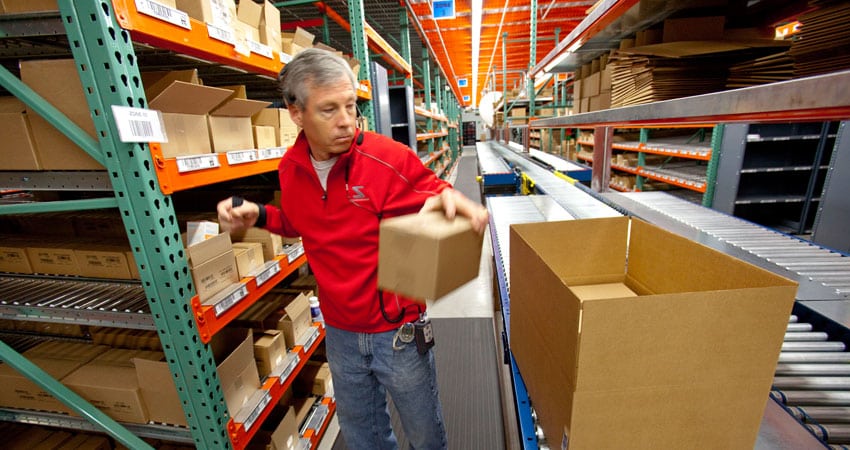Four trends are making hiring for ecommerce fulfillment center employees difficult and expensive for the upcoming holiday season and in the longer term:
- The Bureau of Labor Statistics announced unemployment in April 2019 hit 3.6%, a 49-year low. Many labor markets are even lower than the national rate and are having difficulty finding the warehouse workers they need.
- A growing number of states have passed legislation that automatically increases the minimum wage annually and it’s edging towards $15 per hour. The National Conference of State Legislatures (NCSL) which lobbies Congress on behalf of state legislatures, has a comprehensive table showing state by state increases already planned forward.
- A lot of people are sitting on the sidelines: The Labor Force Participation Rate was only 62.8% in April.
- 31% of the workforce is employed in the gig economy to supplement their incomes. Many workers have a full-time job with regular hours, pay raises, and good benefits. Others describe a very different experience: Fewer hours, only a few days’ notice on work schedules, and little in benefits or pay increases. They are often contractors with no payroll taxes withheld who pay their own taxes and have no benefits.
In an article reporting April’s unemployment, The Wall Street Journal said warehouse hiring due to ecommerce demand rose that month, even as job growth in the freight transportation sector slowed. Warehousing and storage companies added 5,400 jobs in April, according to preliminary figures from the Labor Department, the fourth straight month of growth; nearly 70,000 jobs have been added in the past year.
As we have blogged for several years, there are not enough ecommerce fulfillment center workers to fill the growing number of jobs in many markets. Brian Devine, senior vice president of logistics staffing firm ProLogistix, told WSJ he is seeing “huge growth” for logistics and ecommerce workers in key hubs like Southern California’s Inland Empire, areas of New Jersey near New York City, Atlanta, Indianapolis and Memphis, but not enough workers are available and filling positions is difficult. He said the average wage for ProLogistix workers jumped 6.8% in April to $13.81 an hour.
This may be the perfect storm: A tight labor market insufficient for growth and holiday hiring. Are your ecommerce fulfillment center operations becoming efficient quickly enough to offset these labor increases? For most companies the answer is a resounding NO. Here are three projects every fulfillment should undertake to drive more productivity.
Managing Labor More Effectively
As fast as ecommerce and omnichannel is changing, do you have the time, money and talent to gain the necessary efficiency? Are you innovating in operations quickly enough to lower costs without dropping the ball on customer service? Is there enough time and budget set aside to reach specific breakthrough advances? Here are three projects that would benefit many ecommerce fulfillment centers.
Three Project Examples
Project 1
Determine how to report productivity by department and employee
Benefits: Report actual vs. planned cost for units, orders and packages shipped weekly. Ultimately, report goals vs. actual costs to improve management of labor and budget. When you consider the total cost of fulfillment, in most businesses labor represents more than 50%.
Objectives: Report hours worked and labor costs by department – receiving, put away, replenishment to forward, picking, packing, shipping, returns, DC inventory control. Research phase should include collecting hours worked by function and employee; combined with units of work achieved in the same time period. Have ability to record when employees change functions during the day (e.g. from receiving to returns processing)? What are the ballpark costs for the systems and the data capture equipment?
Most employees want to do their best work for their employers. Yet many times companies don’t give employees feedback on key measures of productivity. You can find ways to change that in our past blog.
Project 2
Perform a feasibility study to determine how your fulfillment center functions could be greatly improved through implementing a standalone WMS
Benefits: Ability to track labor costs and inventory more closely throughout your operations. Ability to add other modules such as labor management, inbound and outbound transportation management systems.
Objectives: The present OMS would remain in place. What major functions could be enhanced or are new to the operations process and systems? Could there be labor savings?
Here is an objective way to evaluate the benefits of a replacement WMS for your fulfillment center, and 13 project management steps for selecting a new WMS.
Project 3
Improve line managers’ ability to manage operations throughout the fulfillment center.
Benefits: Reduce errors and labor costs, provide better direction and nurturing of employees under their control, reduced absenteeism, etc.
Objectives: Identify individual needs of line managers. Develop a plan for improvement with each one. Identify educational programs through community colleges, university, consultants or online programs. Are there specialized one- or two-day courses that senior management could prepare and present? Estimate budget, timeframe and potential results.
Challenge your employees to make more money for the company. Show them how they benefit. Educate them to why investment is critical to the future.
Benchmarking also is key to improving profitability and process improvement. This case study illustrates how one company started internal benchmarking program
Most ecommerce fulfillment center operations can benefit from these projects and realize a return on investment. Happy innovating!
Brian Barry is President of F. Curtis Barry & Company

